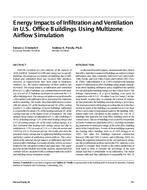Description
With the exception of a few analyses of the impacts of ANSI/ASHRAE Standard 62-1989 and energy use in specific buildings, the energy use in commercial buildings due to infiltration and ventilation flows has received little attention. However, as improvements have been made in insulation, windows, etc., the relative importance of these airflows has increased. The energy impacts of infiltration and ventilation flows in U.S. office buildings was estimated based on the analysis of a set of 25 buildings developed to represent the U.S. office building stock. The energy calculation was performed by a bin method with infiltration flows determined by multizone airflow modeling. The results show that infiltration is responsible for about 13% of the heating load and 3% of the cooling load for U.S. office buildings. In newer buildings, infiltration is responsible for about 25% of the heating load and 4% of the cooling load due to the higher levels of insulation. The total annual energy impact of infiltration in U.S. office buildings is 60 PJ of heating energy (15% of the total heating energy) and 6 PJ of cooling energy (4% of the total cooling energy). It is also estimated that heating and cooling energy use due to ventilation is 17 PJ at a rate of 2.5 L/s (5 cfm) per person and 138 PJ at 10 L/s (20 cfm) per person. The results also show the potential energy savings due to tightening building envelopes and better control of ventilation system airflows. This calculation of the national energy impacts of infiltration and ventilation in office buildings is a rough estimate, with its accuracy limited by the calculation method and input data. This paper presents an intermediate step of this analysis, and an improved estimate will be calculated with a combined multizone airflow and building energy simulation model.
Authors:Steven J. Emmerich, Andrew K. Persily, Ph.D.
Citation:IAQ and Energy 98 Using ASHRAE Standards 62 and 90.1 Conference Papers
Keywords:October, Louisiana, 1998
Citation: IAQ Conference: IAQ 98
Product Details
- Published:
- 1998
- File Size:
- 1 file , 290 KB
- Product Code(s):
- D-8140




